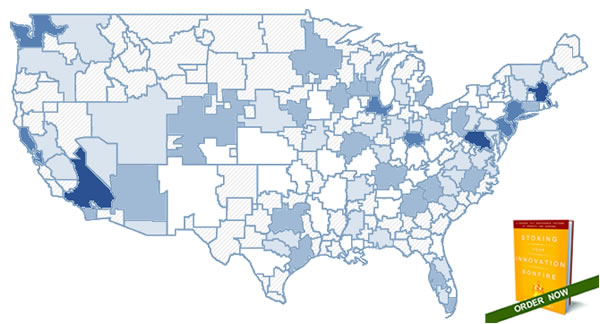 We live in an increasingly complex world where both the volume of change and the pace of change are accelerating. But it is not just change that is accelerating, choice is proliferating as well.
We live in an increasingly complex world where both the volume of change and the pace of change are accelerating. But it is not just change that is accelerating, choice is proliferating as well.
Witness the example of General Mills’ Cheerios. Introduced in 1941, there are now 13 varieties of Cheerios on the market, not including snack mixes introduced in 2008.
In its 70+ year history, General Mills introduced no variations in the first 35 years; all of the new varieties have been introduced during the second half of Cheerios’ lifespan, with eight of 13 new varieties being introduced in the last decade. The 13 current varieties of Cheerios (with launch dates) according to Wikipedia are:
- Cheerios (1941)
- Honey Nut Cheerios (1979) (see above)
- Apple Cinnamon Cheerios (1988)
- MultiGrain Cheerios (Original in the UK) (released 1992, relaunched 2009)
- Frosted Cheerios (1995)
- Yogurt Burst Cheerios (2005)
- Fruity Cheerios (2006) (Cheerios sweetened with fruit juice)
- Oat Cluster Crunch Cheerios (2007) (sweetened Cheerios with oat clusters)
- Banana Nut Cheerios (2009) (sweetened Cheerios made with banana puree)
- Chocolate Cheerios (2010) (Cheerios made with cocoa)
- Cinnamon Burst Cheerios (2011) (Cheerios made with cinnamon)
- Dulce de Leche Cheerios (2012) (sweetened Cheerios made with caramel)
- MultiGrain Peanut Butter Cheerios (2012) (Multigrain Cheerios with sorghum, not wheat, and peanut butter)
We have an overwhelming amount of choice in the supermarket, but we also have an ever growing roster of entertainment options as well:
- Terrestrial, cable, satellite, and on demand television
- Internet television (NBC.com, Comcast.com, Netflix, Amazon Prime, Hulu Plus)
- Television on DVD or DVR
- Over the air, satellite, and internet radio
- YouTube, Vimeo, Vine and streaming music
- Instagram, Facebook, Twitter, Google+
- Console, PC, Tablet, and Smartphone gaming
- Snapchat and Wechat
- Live events and recordings of live events
- and on and on
Advertising is proliferating:
- TV and radio advertising
- Out of Home advertising (Billboards, buildings, airplanes, buses, trucks, etc.)
- Print advertising (Magazines, newspapers, etc.)
- Movie and TV product placements
- Movie theater advertising
- Airborne advertising
- In game product placements
- Digital advertising (banners, videos, etc.)
- Mobile advertising
- Naming rights (stadiums, etc.)
Marketing is proliferating too:
- Direct marketing (direct mail, email, telemarketing, etc.)
- Partner marketing
- Search Engine Optimization (aka SEO)
- Search Engine Marketing (aka SEM)
- Social Media marketing
- Inbound marketing
- Content marketing
- Viral marketing
- Loyalty and retention marketing
- Spam
- and my least favorite (contact form marketing – aka spam)
With this deluge of choice and competition for our attention, people are in fact more annoyed and less affected by advertising and marketing than ever before.
Growing Customers in a Deluge
So in today’s world, how do most effectively cultivate future customers, strengthen the relationship with existing customers, and maintain connections and grow commitment over time?
There is no single answer of course, but effective marketing in today’s world of endless choice and competition for people’s attention requires the appropriate mix of push and pull and recognizes that the ROI from marketing efforts should not all be attributed to the last click but instead is attributed to the overall customer journey and uses technology that allows you to connect together the different customer touchpoints and impressions over time to help you better understand how your holistic revenue generation system is working. Because effective marketing is not about converting leads, but instead about building relationships.
When your marketing efforts focus on building a relationship, trust, and even partnership with your customers, your organization stands to benefit more than by just seeking the quick scale. Even non-customers can be referrers and recommenders, and as companies grow, a single individual can have a customer, partner, and a competitor relationship with the same organization.
Are you living in marketing’s past?
So if marketing today is more about the customer journey, building relationships and even co-creation, then it becomes even more important to build understanding and trust. The power of the story, the power of experience, and the role of content in this new world become increasingly important in capturing and holding people’s attention. You’ll notice that I said people not customers or prospects, and their is an important reason underlying it.
Because of our increasingly interconnected and always on world, where Yelp has grown to become a more powerful engine of influence than neighbors and co-workers, it’s getting harder to tell who is an influencer and must tell a consistent story not just to prospects, but to all people. And in a world where algorithms determine whether you even appear in the places your potential customers trust, having the right content in the right places, at the right time, so that people (not just prospects) can find it at the various stops along the often long, meandering non-customer to prospective customer evolutionary path.
Embracing an expanded marketing focus on non-customers may be hard for some marketers, but others will see the importance of it in growing and maintaining the long-term health of the organization’s sales pipeline and brand equity.
How do you grow new customers?
Well, by growing the level of comfort and trust that people have in your organization and its employees. There are many ways to do this, but they require a strategy that first seeks to understand the typical paths that people take from non-customer to customer. A lot of people talk about trying to loyalize customers, or turning customers into advocates, and while that may sound logical, there is a flaw in that thinking. The flaw is that people can be influencers and advocates for your products and services before they become a customer (or who may never become a customer) if you’re doing a good job with your people-centric marketing.
When you better understand the journeys people take from non-customer to customer you can better understand what parts of the story to tell when and where. And often as you shift from a lead-generation, prospect-driven marketing focus to a people-centric one, you will start to see that in order to build the comfort and the trust and the excitement, that it will be more about barriers than benefits, more about problems than solutions.
As marketers we love to talk about benefits and solutions, but where we really need to focus is problems and barriers. Where is the friction? Where is the confusion? What are the chasms to be crossed? What are the pitfalls to be avoided?
When we start to understand these things, we will start to understand the stories and the content that need to be told and created in order to provide the jet pack to accelerate an individual from one level of comfort, trust, and purchase readiness to the next. The better we grasp what people are seeking to understand in order to evolve their level of comfort and trust, the better we can do at shaping our messages and our strategy to meet people where they are.
Who’s your thought leader?
This is where having a thought leader on staff comes into play, and why you might want to hire one or convert an existing employee or two into one. The job of the thought leader is to be a storyteller, a brand advocate, and ultimately to be the person that builds those bridges across the chasms and guides non-customers along their journey of understanding by demonstrating understanding of the problems, barriers, and pitfalls that non-customers and customers face, and helping to educate them on some of the ways that progress can be made and success created.
There is nothing wrong with trying to lead the thoughts of others. Someone has to lead, or at least to provoke. Just keep your ego at bay and focus on being a discussion leader and a facilitator within the topic area you are focusing on and key in on the transitions that you are trying to encourage. Ultimately what you are doing is growing customers, but there is no set timetable for when a non-customer might become a customer, and we’re not focused on speed as much as we are on acceleration. The closer we can draw non-customers to us, the more likely they are to want to become employees, partners, co-creators, advocates, or even aid in creating post-purchase rationalization instead of buyers remorse.
But the sad part is that most companies don’t recognize the importance of thought leaders, and the unique skillset that some people in understanding the journey and the problems, pitfalls, barriers, chasms, and transitions that matter to non-customers. Most consultancies want their consultants on the road billing every possible hour, and don’t allow anyone to focus on this important area of growing future customers. They dabble, and maybe they publish a white paper here or there that looks just like the white paper their five other competitors just put out, but they don’t commit to any marketing activities that result in immediate lead generation. There are a few consumer product companies that are doing surprisingly well in this area, but the two areas of greatest opportunity probably lie in the business-to-business (B2B) and service industries (consulting, legal services, etc.).
I’ve done a bit of work in these areas helping companies like Innocentive, Planview, Imaginatik, and Crowd Computing create single content input, multiple content output strategies to help evolve their ranks of non-customers along their journey with some informational pieces.
Thought leaders can and should play a large role in your innovation efforts as Evangelists (see my Nine Innovation Roles) and in helping your organization do a better job of value translation and value access (see my article on Innovation is All About Value). As you launch innovations into the marketplace, a people-centric marketing approach can make a huge difference in translating the potential value better for customers and non-customers alike and identifying areas of opportunity for improved value access (based on the thought leaders’ understanding of the non-customer’s journey) that can be communicated within the organization and new value access offerings that complete the core value creation of the innovation.
I hope by now you see the importance of focusing more on people-centric marketing and in understanding non-customers as well (or better) as we currently understand our customers.
But, of course in order to become a thought leader, someone must inevitably find what you have to say worth following.
So identify the thought leaders in your organization, or hire one, and start building your people-centric marketing strategy today!
Image source: bashfoo.com

 Sign up here to get Human-Centered Change & Innovation Weekly delivered to your inbox every week.
Sign up here to get Human-Centered Change & Innovation Weekly delivered to your inbox every week.

![]() Sign up here to get Human-Centered Change & Innovation Weekly delivered to your inbox every week.
Sign up here to get Human-Centered Change & Innovation Weekly delivered to your inbox every week.




 We live in an increasingly complex world where both the volume of change and the pace of change are accelerating. But it is not just change that is accelerating, choice is proliferating as well.
We live in an increasingly complex world where both the volume of change and the pace of change are accelerating. But it is not just change that is accelerating, choice is proliferating as well.

 Describing push marketing is easy (or at least it should be). Push marketing is the traditional marketing and advertising seen everywhere. Push marketing starts with the product or service, identifies the features or benefits that potential customers will find most compelling, and then utilizes targeting and segmentation to “push” carefully crafted marketing messages out via a variety of advertising, sales, and social media channels to the most likely potential customers.
Describing push marketing is easy (or at least it should be). Push marketing is the traditional marketing and advertising seen everywhere. Push marketing starts with the product or service, identifies the features or benefits that potential customers will find most compelling, and then utilizes targeting and segmentation to “push” carefully crafted marketing messages out via a variety of advertising, sales, and social media channels to the most likely potential customers.